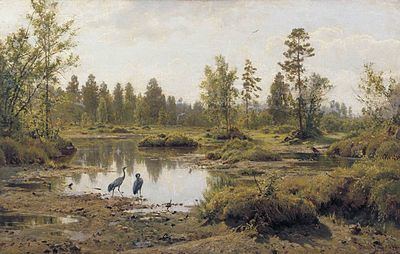Elevation 135 m | ||
 | ||
The Pinsk Marshes (Belarusian: Пінскія балоты, Pinskiya baloty), also known as the Pripet Marshes (Belarusian: Прыпяцкія балоты, Prypiackija baloty) and the Rokitno Marshes, are a vast natural region of wetlands along the forested basin of the Pripyat River and its tributaries from Brest to the west to Mogilev to the northeast and Kiev to the southeast. It is one of the largest wetland areas of Europe. The city of Pinsk is one of the most important in the area.
Contents
Map of Pinsk Marshes, Volyn Oblast, Ukraine
Overview
The Pinsk Marshes mostly lie within the Polesian Lowland and occupy most of the southern part of Belarus and the north-west of Ukraine. They cover roughly 104,000 square miles (269,400 km2) surrounding the sandy lowlands of the dense network of rivers and rivulets forming on both sides of the Pripyat River, one of the main tributaries of the Dnieper. Dense woods are interspersed with numerous swamps, moors, ponds and streams extending 300 miles (480 km) west to east and 140 miles (225 km) north to south. The marshes undergo substantial changes in size during the year, with melting snows in springtime and autumn rainfall causing extensive flooding as the river overflows. Drainage of the eastern portion began in 1870, and significant areas have been cleared for pasture and farmland.
Historically, during most of the year, the marshes were virtually impassable to major military forces, thus influencing strategic planning of all military operations in the region. The Roman historian Procopius related a story that the early Slavs hid out from predators in the Pripet Marshes by breathing through reeds. (Procopius, Wars of Justinian, Volume VII)
History
As in most wetlands in Europe in the past, the Pinsk Marshes were seen as an unhealthy area, a focus of maladies. In the late 19th century, drainage of the marshes recovered 1.5 million hectares of wetlands.
At the start of World War I the marshes separated the Austro-Hungarian fourth army from the XII corps; the few roads that traverse the region were narrow and largely unimproved.
This left a wide gap open, and the 3rd Army Corps of the Imperial Russian Army poured in before the Austro-Hungarian second army's transfer from Serbia was complete. The Russians soon captured the valuable railhead at Lemberg, in the far east of then Austria-Hungary (now part of the western Ukraine), as a result. Throughout the following years of the war the wetland area remained one of the principal geographic obstacles of the Eastern Front in World War I.
The marshes divided the central and southern theatres of operation during World War II, and served as a hideout for Soviet and Polish partisans. At one stage during the war the German administration planned to drain the marshes, 'cleanse' them of their 'degenerate' inhabitants, and repopulate the area with German colonists. Konrad Meyer was the leader in charge of the 'Pripet plan'. Hitler scuttled the project late in 1941, as he believed that it might entail dustbowl conditions. German racial anthropologist Theodor Poesche proposed, in the late 19th century, that the Aryan race evolved in the marshes due to the prevalence of albinism.
In 1942 after an uprising, approximately 1,000 Jews were able to escape from the Łachwa Ghetto, of whom about 600 were able to take refuge in the Pinsk Marshes.
Known as Pripjet-Sümpfe by the Germans, the wetlands were dreaded by the Wehrmacht troops. During the German invasion of the Soviet Union, the Third Reich armies had skirted the wetlands, passing to the north or to the south of them. But after the debacle of the Eastern Front in 1944 many retreating units such as the 7th, 35th, 134th and 292nd Infantry Divisions had to cut across the marshy areas. They often needed to build tracks with logs over which they could pull light loads in horse-drawn vehicles.
There was a plan to drain the wetlands during 1952 when the area of the marshes was under Soviet administration.
In 1986 the region became world-famous through the Chernobyl disaster; however, the Pripet Marshes should not be confused with the ghost city of Pripyat. That ill-fated community within the Chernobyl Exclusion Zone is located 356 km (221 mi) east-southeast of the geographic center of the Pinsk Marshes area.
